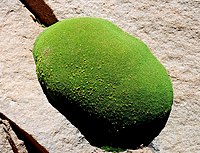Yareta
| Yareta | |
|---|---|

| |
| in Lauca National Park, Chile | |
| Scientific classification | |
| Kingdom: | Plantae |
| Clade: | Tracheophytes |
| Clade: | Angiosperms |
| Clade: | Eudicots |
| Clade: | Asterids |
| Order: | Apiales |
| Family: | Apiaceae |
| Genus: | Azorella |
| Species: | A. compacta
|
| Binomial name | |
| Azorella compacta Phil. | |
Yareta or llareta (Azorella compacta, known historically as Azorella yareta, from yarita in the Quechua language) is a velvety, chartreuse cushion plant in the family Apiaceae which is native to South America. It grows in the Puna grasslands of the Andes in Peru, Bolivia, northern Chile and western Argentina at altitudes between 3,200 and 5,250 metres (10,500 and 17,220 ft).[1][2]

Description
Yareta is an
The plant prefers sandy, well-drained soils. It can grow in nutritionally poor soils that are acidic, neutral or basic (alkaline) at altitudes of up to 5,200 metres (17,100 ft).
Yareta is estimated to grow approximately 1.5 centimetres (0.59 in) per year.[2] Many yaretas are estimated to be over 3,000 years old.[6] These oldest ones have been reported to grow as slowly as 1⁄18 inch (1.4 millimeters) per year.[7] Its very slow growth makes the traditional practice of harvesting it for fuel highly unsustainable.[8]
Gallery
-
Plant in crevice inPotosí, Bolivia
-
Close-up showing seeds
-
Texture of surface
-
Flowers
References
- ^ "Image of Azorella compacta". chileflora. Retrieved 28 October 2015.
- ^ .
- .
- PMID 25292282.
- ^ S2CID 37079723.
- ^ Stenger, Richard (2019-11-28). "The oldest living things on Earth". CNN Travel. Retrieved 2020-01-09.
- JSTOR 2388107.
- ^ "See the world's oldest organisms".
External links
 Media related to Azorella compacta at Wikimedia Commons
Media related to Azorella compacta at Wikimedia Commons- Azorella compacta pictures from Chile




